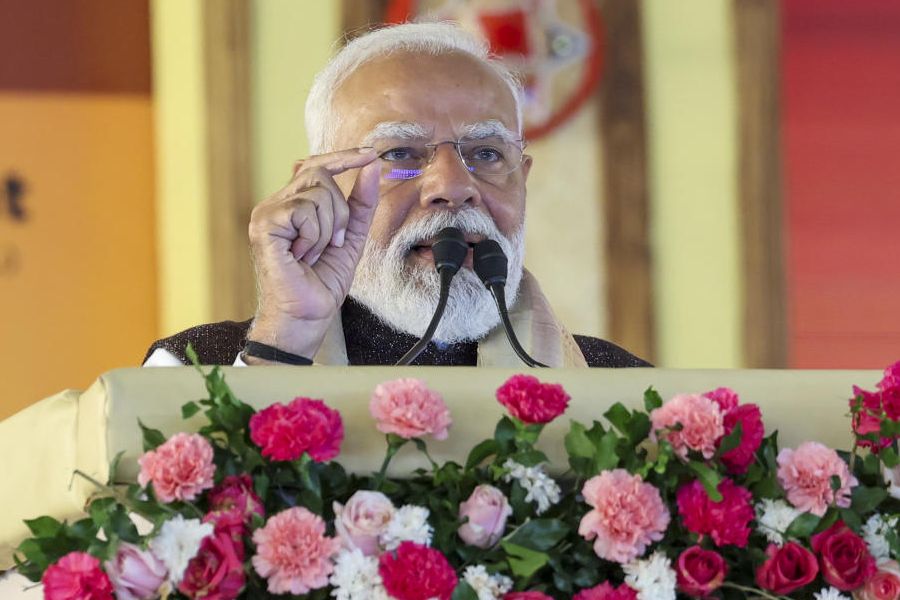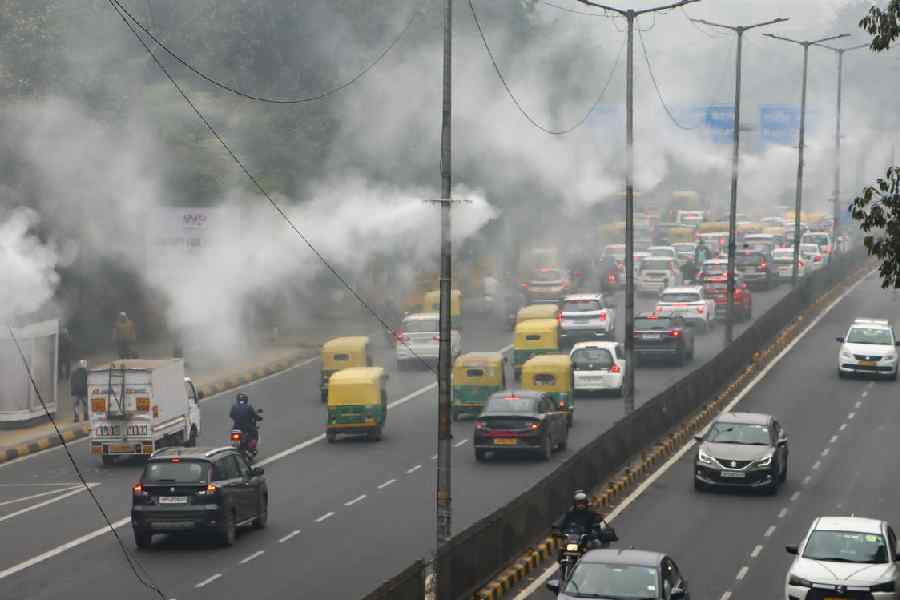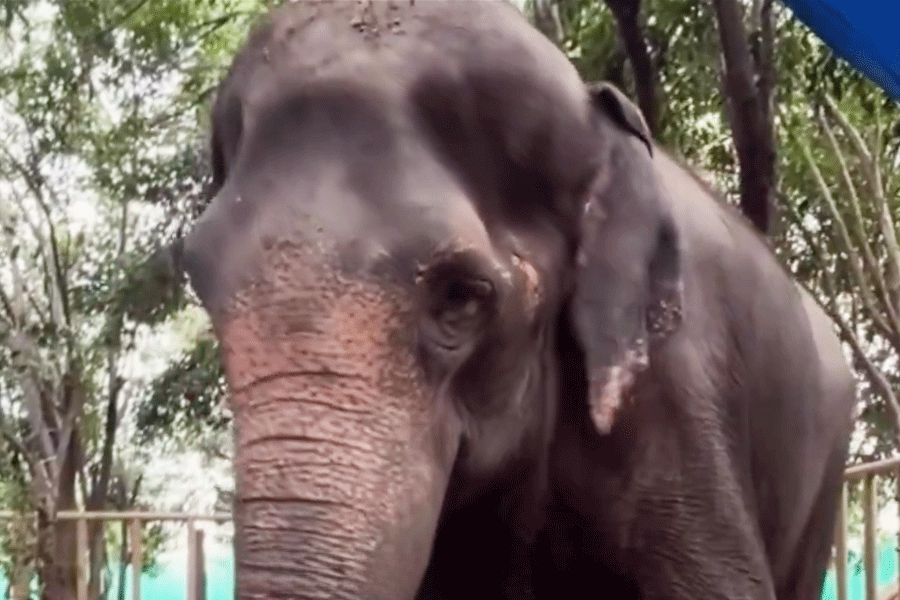It’s a tall order to put into words a Bengali’s love for his food. Just as it’s tough to explain Mamatadi’s fixation with morchas. Or Subhashda’s sudden religious zeal! Or even Arjun Singh’s refusal to take his foot out of his mouth.
And just as during election time, our politicians grow even more potty, during the Pujas, a Bengali’s love affair with food assumes gastronomic proportions. The para ponktibhojan, the prosadi sandesh, Runamaashi’s maacher kalia, Montuda’s mutton roll and Bilash’s phuchka and alur-dom— it covers just about everything that can be consumed.
We asked some Bengalis about town what flavours dominated their thalas during the festival. And in between all that food talk, we got them to open up about those memories and special moments, which only a festival like Durga Puja can bring.
KOEL MULLICK: actress
 |
Durga Puja for me, is a time for tradition, a time for euphoria and a reason to revel. As a young girl, I remember looking forward to the Pujas with almost breathless anticipation. Of course, it was a given that all the kids in the family would automatically turn hooligans. We’d constantly be up to mischief, monkeying around the place. Yet at the same time, we recognised that for the elders of our family, there was no other festival as auspicious as this!
Years ago, our family puja used to take place at Gooptipara in Hooghly. Since 1925 though, it has been celebrated with much fanfare at Mullickbari in Bhowanipore. Our relatives from all over the world descend on Mullickbari for those four days, and needless to say, it’s chaos and camaraderie rolled into one.
Our barir pujo is still conducted according to the traditions of old. The rituals begin early in the day with the elders beginning their fast. For us younger ones, it’s an auspicious time as well and we don’t eat anything before offering anjali.
But besides having a sense of reverence and devotion, our family also whole-heartedly believes in having fun. Each year we stage our very own play and everyone gets in on the act — from playing the hero or heroine and directing to even prompting. It’s always a laugh when those who never remember their lines gingerly edge towards the wings for a bit of prompting. In fact, I think the prompters end up winning the most applause!
Equally, if not more lauded are the women of our family who pull out every culinary punch to whip up one delicacy after the other. Over the first three days of Durga Puja, the table is laden with a jaw-dropping variety of vegetarian fare. The maach and mangsho come to the fore on Dashami. But from it all, if I were to home in on one speciality, it would have to be Meter Chachchari, a spicy liver delicacy that always has me wanting more.
Recipe: Meter Chachchari
Ingredients: mutton liver — 1kg; pumpkin — 1kg; puishaak — 1kg; radish (large) — 4; potatoes — 1/2kg; onion —1/2kg; mustard oil — 250gm; ginger paste — 100gm; garlic paste — 100gm; tomato paste — 400gm; turmeric — 1tsp; paanch phoron; green chillies
Method: Chop the liver into small pieces. Dice the vegetables. Grind onions into a rough paste. Heat oil in a pan, add the onion paste and brown well. Add the ginger and garlic paste along with the tomato paste. Add turmeric. When the spices come on the oil, add chopped liver and salt and fry well. Add the vegetables and mix. Add a little water and sugar to taste. Serve with steamed rice.
SANJAY BHATTACHARYA: artist
 |
Every year my family and I manage to escape the madness and mayhem of the city by spending the Pujas in a beautiful Santhal village in Shantiniketan. This has been our sanctuary since 1989. We put up there in the home of my wife’s cousin, art professor Bandhan Das, who started this puja in which the locals are involved in every minute detail, including the making of the idol. Earlier the idol would be made of terracotta, but subsequently materials like iron, wood and clay have been used. And the protima that is created is unlike any you’ve seen in Calcutta. Even the puja, which takes place in the middle of a forest of Sonajhuri trees, is very poignant.
The fare laid out is also very heartening — the prasad comprises khichudi, mangsho and taari (an alcohol made from palm fruit or tal). Indeed the atmosphere is so charming. It’s like an entirely different way of life unfolding before your eyes.
This year though, due to various hiccups, I’ll be giving Shantiniketan a miss and remain in Delhi. Yes, I will probably be cooped up in my studio. But then again, my sons refuse to stay indoors, so I guess spending time at the two pandals in New Rajinder Nagar and Old Rajinder Nagar will be on the cards.
While we will sample the bhog at these pandals, what I am really looking forward to is the bhog cooked by my wife, Bulbul on Ashtami. She makes a wonderful khichudi, begun bhaja (eggplant fry) and labra — all of which is offered in a shwet patharer thala to the deities in our small temple at home. Of all the bhog preparations, my pick is the labra — a delicious blend of seasonal vegetables characterised by the sweetness of pumpkin and the flavour of paanch phoron.
Recipe: Labra
Ingredients: sliced pumpkin — 1/2 cup; cauliflower — 1/2 cup; shredded cabbage — 1/2 cup; cubed radish — 1/2 cup; chopped beans — 1 cup; chopped flat beans (shim) — 1 cup; cubed egg plant — 1/2 cup; chopped pointed gourd (patal) — 1/2 cup; sliced snake gourd (jhinge) — 1/2 cup; cubed sweet potatoes (with skin) — 1 cup; vegetable oil — 2tbs; ghee — 1tbs; bay leaves — 2; paanch phoron — 10gm; ginger paste — 2tbs; cumin seeds — 1tsp; turmeric paste — 1tsp; green chillies — 10gm; dry chillies — 10gm; salt to taste; sugar to taste; water — 1/2 cup
Method: Wash all the vegetables together, strain the water and keep aside. Pour the vegetable oil into a wok. Add bay leaves, dry chillies, green chillies, paanch phoron, turmeric paste, salt and sugar. Fry well for a few seconds. Next, blend in the vegetables with the spice mixture. Add water, cover wok with a lid and allow it to simmer for a few minutes. When it is almost done and 5-7 minutes before taking the wok off, add ginger paste, cumin seeds and ghee. Serve hot.
BIKRAM GHOSH: musician
 |
I spent the first few years of my childhood in the US and was about six when we shifted back to India. I remember the Pujas being a sort of cloudburst of sensations after the aseptic environs of the States. We used to live on Kabir Road then and the neighnourhood pandal was located at the foot of our house. I’d stare down for hours from the balcony, taking in the preparations for all I was worth. The festive colours, the fragrant smell of dhuno and dhup, the sounds of dhak and mantra and the soft whispers of a crisp new tanter sari — I’d get lost in the immensity of it. And then, there was music! My parents, their students, family, friends — for everyone Durga Puja meant music. Our house would be steeped in music during those four days.
The Pujas also meant the extended family coming over, which was very special for me, being an only child. I have fond memories of the chaos that would ensue — pandal-hopping with all my cousins packed in a car like sardines, getting lost, getting found, getting scolded. I loved it all.
As I grew older, I began to participate more actively in the celebrations — collecting chaanda and staking out my place in the pandal. But as the demands of my profession grew, I took a hiatus from all that. I think I’d stayed away from Calcutta during the Pujas for about 12 years. But after 2003, I resolved not to miss out any more. This year is going to be extra special for us, as my son Tatin will do his first round of pandal-hopping.
The Pujas also spell food for us just like any other Bengali family, though personally I feel mine is a family of mahapetuks. Set food before us and I swear, we behave like we never get enough to eat at home. We simply lose control!
When I was a kid, the Puja days would start with serious discussions about whether there’d be luchi for breakfast and what the menu would hold for lunch. My mother, my aunts, our cook Sudhakar — everyone would pitch in with all their might. Of course, we wouldn’t leave out the parar bhog and baire khawa — Moghlai or Chinese or Continental on Park Street. We were game for everything. And we still continue that glorious gastronomic tradition.
One recipe that’s made inroads onto the Puja menu after I got married to Jaya is Chingri Maacher Paturi. As a seafood buff, I can never get enough of lobster, prawn and shrimp. Also, it’s so easy to make. All in all, this recipe which Jaya taught me (she learnt it from her mother) is a real winner!
Recipe: Chingri Maacher Paturi
Ingredients: large prawns — 1kg; mustard paste — 4tsp; coconut paste — 8tbs; mustard oil — 8tbs; salt to taste.
Method: Wash and de-vein prawns. Sprinkle salt and set aside for 30 minutes. Wash again and add salt, mustard paste, coconut paste and oil. Marinate for 30 minutes. Wrap in banana leaf, put in a baking dish and bake in oven for 30 minutes. Serve hot
BABUL SUPRIYO: singer
 |
I get very nostalgic during the Pujas. We used to celebrate in a big way at our ancestral house in Bandel, so for me the festival brings back a flood of happy memories. It was all about dressing up in new clothes, offering anjali and meeting up with friends and relatives. The puja at my ancestral home continues to this day and last year, we celebrated 150 years. But now, living in Mumbai, all I can do is recall those carefree days.
When in Mumbai during the Pujas, I’m besieged by offers to perform at shows, sometimes even abroad. This year I’m travelling to San Francisco to perform for the Bengali Association there. So I don’t really have any definitive plans for the Pujas.
My one and only plan though, is to eat my heart out. Like all Bengalis, I’m a complete foodie. At home, we go vegetarian during Shasthi and Ashtami. But on Nabami, an elaborate non-vegetarian spread is laid out. The dish that I most associate with Durga Puja is Mutton Bhuna. Now this has gone through several permutations and combinations, so I now call it Mutton Babuli. Not for nothing do most visitors to my house insist on tasting it!
Recipe: Mutton Babuli
Ingredients: mutton — 1kg; onions — 10-12; potatoes — 6; medium-size tomatoes — 5; curd — 500gms; turmeric powder — 2tsp; red chilli powder — 2tsp; Bolst’s Curry Powder (optional) — 1tbs; salt; mustard oil; white vinegar — 3tsp; lime juice — 2tsp; sugar — 2 tbs; green chillies; bay leaves
Method: Marinate the mutton in curd, white vinegar, 2tsp of turmeric powder and 2tsp of red chilli powder. Refrigerate for two-and-a-half hours.
Next remove from the fridge and keep aside for half-an-hour. Slice half the onions. Slice tomatoes and halve potatoes. Heat oil in the kadhai and add 2 bay leaves. When crackling, add onions and fry for a while. Add tomatoes and fry till golden-brown. Sprinkle 2tbs of sugar. When oil separates, add mutton. Adding 1tbs of Bolst’s Curry Powder enhances the taste. Add potatoes and 6-7 whole onions. Allow to simmer for some time and add salt. Continue stirring the mutton for about three hours, until golden-brown. Finally, add 2tsp of lemon juice. Serve hot with green chillies and rotis.
SHARBARI DATTA : fashion designer
 |
My earliest memories of Durga Puja hark back to when I was about five years old. Back then we used to stay on Rashbehari Avenue in a house facing the tram tracks. And from the windows, I remember watching all the fun unfold. The entire neighbourhood would be thrown into a frenzy of activity with the dawning of Saptami. The sonorous melodies of the shehnai would reverberate, trucks laden with thakurs would rumble past, the kalabou-snan would take place, and songs by Hemanta Mukherjee would blare from every second house.
While all these customs and traditions still abound today, Durga Puja has metamorphosed into more of a social celebration. And that’s a good thing! Nowadays, even non-Hindus celebrate with so much vigour. Indeed, Durga Puja breeds a sense of unity — a blessing in these times.
I also feel that the pandals today are more aesthetically pleasing than those of yesteryear. There’s a surge of creativity. And more and more are promoting the art and crafts of rural Bengal.
As for me, the four days pass by in a whirl. For the past few years I’ve been on some panel or the other, judging the various pandals. And this year is no exception. I’ve also been invited to inaugurate a puja in Rajarhat.
All that aside though, it’s a time for family and friends and my home is thrown open to one and all. I love cooking and during the Pujas, I whip up a huge variety of dishes. Yes, I keep it all coming — chechra, doi maach, mangsho and my personal favourite, murighonto. I swear by it, and if you give the recipe a shot, I promise, you will too!
Recipe: Murighonto
Ingredients: whole head of fish (rui/katla) — 500gm; gobindobhog/basmati rice — 60gm; tomato — 1 large; onion — 1 large (sliced); green chillies — 3 or 4; turmeric; ground chillies, ground cumin and coriander, ground ginger, garam masala — 2tsp of each; cardamom; cinnamon; cloves; bay leaves — 2, jeera — 1 tsp; red chillies, salt; sugar; mustard oil — 4-5 tbs; a bit of ghee
Method: Wash rice, dry and set aside. Wash fish, add salt and turmeric and fry well. Keep aside and fry rice in the same oil. Set rice aside and add more oil to the pan. Add red chillies, whole jeera, bay leaves, onions, garam masala and tomatoes. When almost done, add rice and sauté. Once spices are cooked, add fish, salt and sugar. Add a little water and stir till rice is cooked. Break heads into smaller pieces with the spatula. Add green chillies and ghee. When water dries, take off the stove. Serve hot with steamed rice.
Photographs by Rashbehari Das, Gajanan Dudhalkar and Rupinder Sharma











